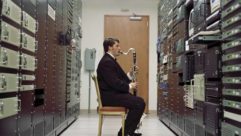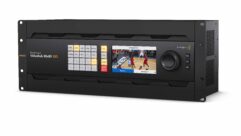
Allen & Heath GLD-80 Review
Jun 7, 2013 11:56 AM,
Reviewer: John McJunkin
A mixer comparable to its more sophisticated and expensive predecessors.

After this year’s NAMM convention I ran into a friend of mine, a prominent live sound engineer, and we talked about what we saw at the show, including the big crop of digital consoles. We were both astonished at the comparative ratio of quality and features versus price with this array of products, noting that the latest digital mixers on the market have a list of features that would have priced them well into five figures just a few years ago. These consoles don’t just have bells and whistles; they also exhibit high-quality audio too. As they continue to get better, more useful, and less expensive, the end-user benefits the most.
Allen & Heath’s entry into this market is the GLD-80, a less sophisticated version of its successful and robust iLive digital mixing system. I was familiar with the iLive system, so I was keen to evaluate a GLD system.
The iLive system features a mix core engine that is controlled remotely by a user interface that any of us would mistake for a mixer. Allen & Heath chose to put the main CPU in a separate enclosure, away from the faders and knobs. This is not the case with the 32-input, 22-output standard GLD-80 system; the entirety of the mix core resides in the mixer’s enclosure.
There are 20 faders on the surface, each with buttons for P/AFL, bus assignment, selection, and mute/DCA assignment. Each also has a five-segment LED meter, multi-purpose rotary encoder knob, and color back-lit LCD scribble display. Put all that together with the 13 rotary encoders and 11 buttons in the channel-strip section of the mixer, along with the 8.4in. TFT touchscreen and other buttons and connectors, one might reach the conclusion that the 29”x 23” surface is crowded, but it’s not. It feels very open, with plenty of space between controls.
I really like the touchscreen, which gives graphical representations of signal routing and processing, and facilitates quick and easy setting of numerous parameters. The I/O on the rear panel is sparse since the system’s stage box is represented and connected by a single network cable. There are four balanced inputs and four balanced outputs on XLR connectors, and I really like this as it enables connection at FOH to outboard processing or monitors. There are also RCA stereo inputs and outputs, and both AES and S/PDIF digital I/O as well. The remainder of the rear-panel connections pertains to the network and MIDI.
Indeed, the bulk of I/O for the GLD system is handled by Allen & Heath’s proprietary dSNAKE protocol with preamplification at the stage box, which is known as the GLD-AR2412. It provides 24 channels of balanced XLR inputs, 12 channels of balanced XLR line outputs, and facilitates connection to expander units for additional channels. Another front-panel network connector provides signal to Allen & Heath’s ME-1 personal monitor unit to allow “more me” mixing. The GLD protocol is compatible with the Aviom A-16 system. The AR2412 connects to the mixer via a Cat-5 cable, up to 120 meters in length.
Allen & Heath have developed an app for the iPad, facilitating comprehensive control over the system. The GLD Remote app functions with the iPad Mini as well, if that’s the device you choose. In addition to the expected controls, the app makes provides a PFL control function to facilitate listening to PFL remotely via wireless. I have come to expect iDevice remote functionality, but I don’t take it for granted, and I’m still thrilled to be able to walk around and tweak with an iPad.
I mixed pop music with the console, and isolated a handful of different mics and musical instruments to get a handle on what it sounds like. The mic preamps are pleasantly warm to my ear, lending the kind of rock-and-roll punch we expect from lead-singer dynamic mics, but they also react nicely to the transients from condenser mics. The equalization and dynamics processing probably impressed me more than any other DSP in the system. Allen & Heath’s people have clearly worked hard to arrive at digital emulations of great-sounding analog gear, and the work has paid off. In particular, the equalizers sound amazing. They sound and behave like analog EQ, but they’re dead quiet and do not suffer any of the digital artifacts that cheap DSP can introduce.
There are four available dynamics processing topologies, including a slow-response opto-coupled unit. With the four types at my disposal, I was able to dial up everything from subtle, transparent level smoothing to rock-em-and-sock-em smash to add bite. Again, the dynamics processing behaved just like analog, particularly the gates. And not to gloss over the mixer’s ambient and time-based processors, but in my estimation, effects take a back seat in the mixing process. If I had to decide between excellent EQ and dynamics or excellent reverb, for instance, I’ll take the EQ and dynamics every day. That said, the effects sound excellent as well, with emulations of units with which we’re all familiar.
Allen & Heath provide basic mix configurations with effects already “installed” in the mixer’s virtual racks and ready to go. The channel-strip section of the interface has knobs for gain, HPF cutoff, gate threshold, compression ratio and threshold, and of course, parametric EQ controls. One thing it lacks are send knobs. While I appreciate the manufacturer’s attention to the idea of an uncrowded control surface, a bank of four more auxiliary/effects knobs would be very welcome. As it is, the way the sends work was not very intuitive to me on a console that was otherwise very intuitive.
The mixer can handle up to 48 input channels, routable through 30 assignable buses to as many as 20 mix outputs. Several flavors of I/O are available via a card slot in the mixer, including ACE, Dante, MADI, Waves, Ethersound, ADAT optical, IDR, and Aviom. It sports both parametric and graphic EQs on each output channel, along with an insert and compressor. There are also 16 DCAs and mute groups, along with robust talkback conventions, a tone generator, and realtime analyzer. The control surface is customizable in terms of signal routing, scribble-strip naming, and numerous other parameters. It facilitates stereo USB recording and playback, and it sounds very good.
It’s interesting to me to see console manufacturers converging on a narrow price range with sophisticated consoles that would have fetched a substantially higher purchase price even just a few years ago. The makers of smaller, less-sophisticated mixers are stepping up their game, while makers of higher-end desks are creating lower-price options that deliver unprecedented features and performance nevertheless—and we all benefit. I can recommend a test drive of the Allen & Heath GLD-80 if it’s plausible for your budget. It’s an easily used console delivering great sound quality at a very reasonable price.
PRODUCT SUMMARY
Pros: Inexpensive digital mixing platform, excellent audio quality,
Cat-5 snake
Cons: Interface makes aux and FX sends and returns a little confusing
Applications: Corporate, conference, seminar, hospitality AV, live
sound venue
Price: $9,999 (GLD-80 mixer); $2,299 (GLD-AR2412 Stage Box)
SPECIFICATIONS
Inputs
XLR Mic/Line Inputs: Balanced, (All XLR on GLD-80 and AudioRacks)
Mic/Line Preamp: Fully recallable
Input Sensitivity: -60 to +15dBu
Analogue Gain: +5 to +60dB, 1dB steps
Pad: -20dB
Maximum Input Level: +32dBu
Input Impedance: >4kΩ (Pad out), >10kΩ (Pad in)
Mic/Line Channel noise: 20-20kHz, Direct Out @ unbalanced out
Mic EIN: -127dB with 150Ω source
Unity gain (Pad in): -90dBu
Low gain (5dB, Pad out): -93dBu
Mid gain (30dB, Pad out): -89dBu
Mic/Line Channel THD+N: 20-20kHz, Direct Out @ unbalanced out
Unity gain (Pad in): 0.005% -86dBu @ 1kHz, 0dBu output
Low gain (5dB, Pad out): 0.003% -89dBu @ 1kHz, 0dBu output
Mid gain (30dB, Pad out): 0.004% -88dBu @ 1kHz, 0dBu output
Outputs
XLR Outputs: Balanced, Relay protected
Output Impedance: <75Ω
Nominal Output: +4dBu = 0dB meter reading
Maximum Output Level: +22dBu
Residual Output Noise: -91dBu (muted, 20-20kHz)
System: Measured balanced XLR in to XLR out, 20-20kHz, minimum Gain, Pad out
Dynamic Range: 112dB
System Signal to Noise: -90dB
Frequency Response: 0/-0.25dB @ 20Hz, 0/-0.5dB @ 20kHz
System peak level THD+N: 0.0055% -68dBu @ +17dBu output, 1kHz
System Line level THD+N: 0.0022%, -84dBu @ +9dBu output, 1kHz
Headroom:+18dB
Internal operating Level: 0dBu
dBFS Alignment: +18dBu = 0dBFS (+22dBu at XLR output)
Meter Calibration: 0dB meter = -18dBFS (+4dBu at XLR out)
Meter Peak indication: -3dBFS (+19dBu at XLR out)
Meter Type: Fast (peak) response
Sampling Rate: 48kHz +/-100PPM
ADC: 24-bit Delta-Sigma
DAC: 24-bit Delta-Sigma
Latency: 1.49ms (GLD-80 local XLR in to XLR out); 0.68ms (GLD-80 local XLR in to digital out)
USB Playback: 2 channel, WAV, MP3, M4A, FLAC 44.1/48kHz
USB Record: 2 channel, 48kHz / 16bit – WAV
I/O Port: 64 channel bi-directional
Card Options: A&H ACE, MADI, Dante, ES, Waves, MMO
Operating Temperature Range: 0 deg C to 35 deg C (32 deg F to 95 deg F)
John McJunkin is the principal of Avalon Podcasting in Chandler, Ariz., and produces and co-hosts a top-rated morning radio talk show in Phoenix. He has consulted in the development of studios and installations and provides high-quality podcast and voice production services.









